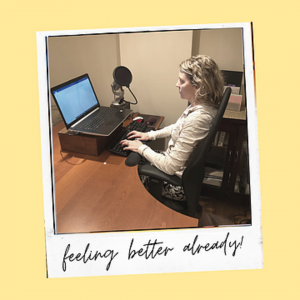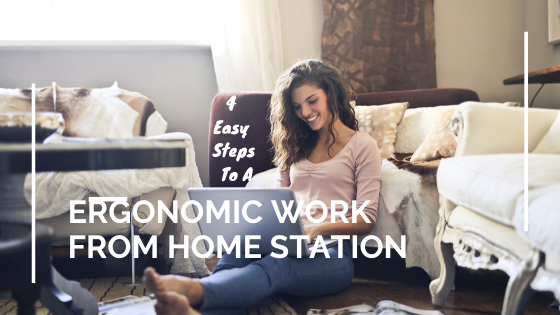This is a special request blog post for my lovely wife Tara. As a result of the COVID-19 pandemic many of us are working from home in whatever makeshift settings we can accommodate. And after a month using our laptops on the kitchen table it doesn’t take long for stiff necks, achy backs and in more extreme circumstances carpal tunnel or thoracic outlet syndrome to set in. As a rule, I don’t provide “physical therapy” for my wife unless she asks. Unfortunately, she has started getting intermittent numbness in her arms after having to work from her desk in the basement and I just couldn’t help myself! We chatted about ergonomic positioning and posture and then I looked at her desk. It was terrible for her neck, back and arms. As a result, we made some relatively simple changes to her desk and now she is much more comfortable.
If you are in pain, have started to get numbness and tingling or have just started to generally feel stiff keep reading for some simple ways to fix your desk too.

Step 1: As you can see from the first picture, Tara’s head is leaning forward and tipped downwards to see her screen because of the positioning of her laptop/screen. Ideally, if you are working from a laptop getting a second screen is best. But we didn’t have one so instead we added an external keyboard and mouse and then propped up her screen with a box (old text books work great for this too). To position your screen, ideally you want the top of the screen at eye level and the distance to be around the tips of your fingers with your arms raised in front of you.
Step 2: Now that we have fixed the position of your head, let’s move down to your shoulders. Because Tara was using the keyboard and trackpad on her laptop it caused her shoulder blades to be slouched forwards. Simultaneously, because her chair’s arm rests were too low, her neck and shoulder muscles had to hold up her shoulder blades all day in that rounded position. This is TERRIBLE for you neck (and the cause of the numbness in her arms). Tara needed a new chair. After a quick trip out to grab a new one (don’t worry… I kept my social distancing and did not get within 6 feet of anyone for the making of this post) we repositioned the chair with the elbow rests all the way up so that her elbows were supported. If getting out for a new chair won’t work for you, take an old towel or throw pillow, roll it up and tape it onto your elbow rests. It will look a little sketchy but at least your neck and shoulders will feel better!
Step 2.5: I also had her move her chair more to the right so that she could sit squarely facing the desk. The curve in the desk where she was working was creating a twist to the chair, resulting in her having to rotate her neck and upper back in order to face her screen, further irritating her neck.
Step 3: Moving further down the arms you will notice the wrist pads and mouse pad that I set up for her. Whether you are using a laptop keyboard or external one, if your wrist is extended (bent backwards) all day you are likely going to develop carpal tunnel at some point in your career. Our wrists are meant to sit in a little bit of an extended position (15 degrees) but more than that and you increase your risk of irritation. Also, by using the wrist pads it is much softer on the part of the wrist that is resting which will also make you more comfortable. If you don’t have wrist pads handy tightly roll up a face cloth and put an elastic band or tape around it for your mouse pad and then do the same lengthwise with a thin hand towel for you keyboard.

Step 4: If we shift our focus to her lower back you will see that the new chair is positioned with the lumbar support in the curve of her lower back. This wasn’t terrible in the old chair but it aligns much better with the new positioning. In the first picture, Tara also had her legs crossed and her feet out in front of her with her knees in about a 60 degree angle. Ideally, the angle in your hips, knees and ankles should all be 90 degrees. For some people this isn’t comfortable or because of the height of their desk/table/chair it’s not possible. In that instance, add in a small foot rest to talk with positioning. If you don’t have a foot rest lying around and old test book or phone book will do the trick in a pinch.

